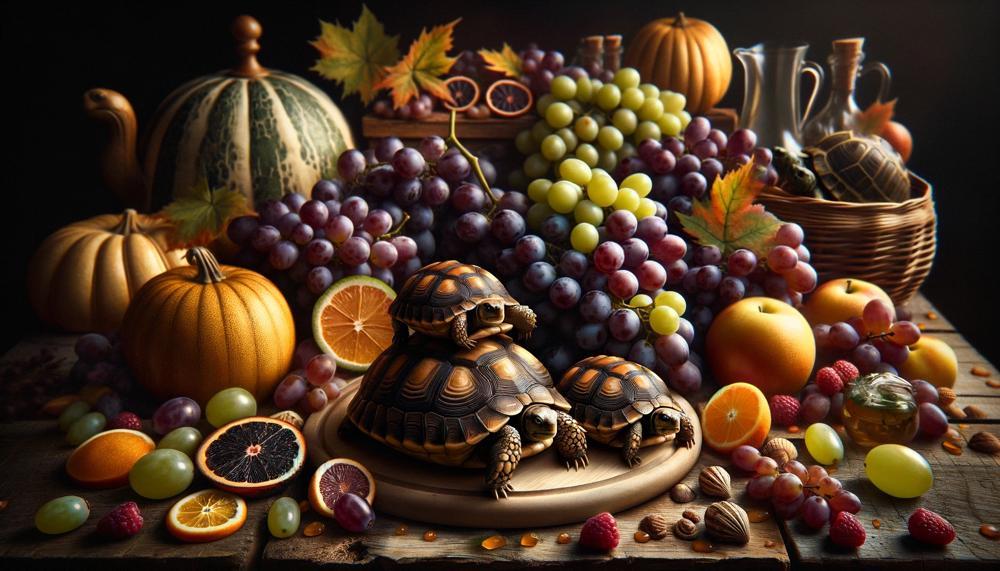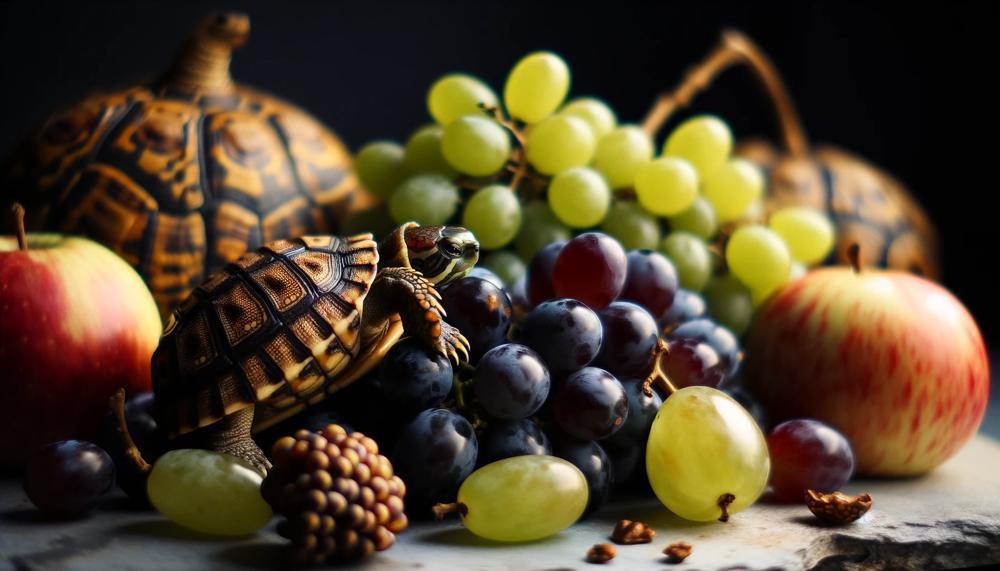Are you the proud owner of a turtle?
Or perhaps you’re considering adding one to your family?
Either way, as responsible pet owners, we all want to provide our shelled friends with a nutritious and balanced diet.
But when it comes to treats, we often find ourselves questioning what is safe for our turtles to eat.
So, can turtles eat grapes?
Yes, turtles can eat grapes, but you should feed them sparingly. Fruits should be fed more sparingly than vegetables because they are often preferred by turtles and tend to be less nutritious. Grapes are juicy and contain high sugar levels, which can impact a turtle’s health. You can give grapes more frequently if you want to spoil them, but you will need to monitor your turtle’s weight.
Contents
- 1 Turtle Essentials
- 2 Understanding Turtle Dietary Needs
- 3 The Role of Fruits in a Turtle’s Diet
- 4 Can Turtles Eat Grapes?
- 5 The Impact of Grapes on Different Turtle Species
- 6 The Potential Health Risks of Feeding Turtles Grapes
- 7 The Proper Way to Feed Grapes to Turtles
- 8 Alternatives to Grapes in a Turtle’s Diet
- 9 Conclusion
Turtle Essentials
Turtles are a diverse group of reptiles, with more than 300 different species scattered around the globe. Their diets vary considerably depending on their habitat, size, and specific species. Carefully considering a turtle’s diet is crucial as it directly affects their health, growth, and overall well-being.
Each turtle species has its unique dietary requirements, and providing a well-rounded diet is vital for their survival and maintaining their distinctive roles in their respective ecosystems.
Understanding Turtle Dietary Needs
Turtles are a diverse group of reptiles, with over 300 species that have varying dietary needs depending on their habitat, size, and specific species. They can be classified as omnivores, herbivores, or carnivores.
Omnivorous turtles consume both plant and animal matter, while herbivorous turtles primarily eat plants and vegetation. Carnivorous turtles prey on smaller animals such as insects, fish, and mollusks.
Turtles’ feeding techniques and adaptations play a significant role in their ability to acquire and process various food sources.
Diversity in Turtle Diets:
Turtles have unique mouth structures adapted to their specific diets. Herbivorous turtles have a diverse diet that includes plants, algae, fruits, and berries. Terrestrial herbivorous turtles mainly consume grasses, leafy greens, and vegetables.
Meanwhile, carnivorous turtles primarily eat meat from aquatic organisms like fish and mollusks. Omnivorous turtles have a mixed diet consisting of both plant-based and animal-derived foods.
Dietary Needs of Pet Turtles:
To keep pet turtles healthy in captivity, they require a well-balanced diet of turtle pellets, fresh foods, and supplements. It is essential to provide a varied diet that resembles their natural diet to ensure they get all the necessary nutrients for their health and growth.
Are Grapes Safe for Turtles?
In moderation, certain human foods like grapes can be safe for turtles to eat. Grapes contain essential nutrients like Vitamin C and antioxidants that can benefit turtles’ health. However, it is crucial to note that grapes should only be given as an occasional treat and not as a regular part of their diet.
Foods to Avoid Feeding Turtles:
While some human foods may be safe for turtles to consume in moderation, there are certain foods that should be avoided altogether. These include goldfish from pet stores or ponds due to potential parasites or bacteria that can harm turtles.
Additionally, it is important to avoid feeding turtles processed or sugary foods, as well as foods high in fat or salt.
The Role of Fruits in a Turtle’s Diet
Fruits are a vital component of a turtle’s diet as they provide essential vitamins and minerals. However, not all fruits are safe or beneficial for turtles to consume. As an expert on the topic, I can offer insights on which fruits are safe for turtles to eat and whether or not grapes should be included in their diet.
Safe and Beneficial Fruits for Turtles:
- Figs: These fruits are rich in calcium and fiber, making them an excellent choice for turtles.
- Bananas: High in potassium and vitamins, bananas are safe for turtles to consume. However, they should be fed in moderation due to their high sugar content.
- Raspberries: These berries are a great source of antioxidants and can be given as occasional treats to turtles.
- Apricots: A good source of vitamins A and C, apricots can benefit a turtle’s immune system.
- Cantaloupe: This fruit is high in water content, providing hydration for turtles.
- Strawberries: Rich in vitamin C and antioxidants, strawberries can be given as treats to turtles.
- Dates: These fruits are high in calcium and can promote healthy shell growth in turtles.
- Pears: A good source of potassium and fiber, pears can be given as occasional treats to turtles.
- Peaches: High in vitamins A and C, peaches can boost a turtle’s immune system.
- Mangoes: These fruits are packed with antioxidants and can improve a turtle’s overall health.
Grapes and Turtles Diet:
While grapes are not listed as a safe option for turtles to eat, they can be included in their diet in moderation. Grapes contain high levels of sugar, which can be harmful if consumed in large quantities. It is important to only offer grapes as occasional treats and always remove the seeds to avoid any potential toxicity.
In conclusion, fruits play a crucial role in a turtle’s diet, providing essential nutrients and variety to their meals. However, it is vital to only offer safe and beneficial fruits in moderation, and always consult with a veterinarian before introducing new foods to a turtle’s diet.
Expert Tips for Feeding Fruits to Turtles:
- Vary the types of fruits offered to provide a well-rounded diet.
- Always remove seeds and pits from fruits before feeding them to turtles.
- Offer fruits as occasional treats and not as a staple food source.
- Consult with a veterinarian before introducing any new foods to a turtle’s diet.
- Avoid feeding overly sugary or acidic fruits, such as citrus fruits, to turtles.
- When in doubt, choose a safe and beneficial fruit that is high in vitamins and minerals for turtles.
The Role of Fruits in a Turtle’s Diet
Fruits are an important part of a turtle’s diet, providing essential vitamins and minerals.
However, not all fruits are safe or beneficial for turtles to eat.
Can Turtles Eat Grapes?
While grapes are generally safe for turtles to consume, they should only be given in moderation. These small fruits are packed with essential vitamins and minerals that can contribute to a well-rounded diet for your shelled friend. However, overindulging in grapes can lead to health issues such as obesity and digestive problems. It’s best to offer grapes as an occasional treat rather than a staple food.
When feeding grapes to your turtle, be sure to remove any seeds and cut them into small pieces. The seeds and skin of grapes can be difficult for turtles to digest and may even be toxic in large amounts. By cutting them into smaller chunks, you reduce the risk of choking or digestive issues.
Furthermore, it’s essential to choose ripe and fresh grapes for your turtle. Avoid feeding them wilted or moldy grapes, as they can make your turtle sick. If you’re unsure about the quality of the grapes, you can always consult with a veterinarian for advice.
The Impact of Grapes on Different Turtle Species
Grapes are a well-liked fruit among humans and can also be a nutritious addition to the diet of certain turtle species. However, it is crucial to understand the potential effects of grapes on turtles and if there are any specific types of grapes that are safe for them to consume.
Potential Effects of Grapes on Turtles:
- Nutritional Benefits: Grapes contain essential vitamins and antioxidants that boost the immune system and overall health of turtles. These include vitamin C, vitamin K, and beta-carotene.
- Energy Boost: The quick energy provided by grapes can be beneficial for turtles, especially during periods of increased activity or growth.
- Hydration: Turtles require proper hydration levels, and grapes can contribute to this due to their high water content.
- Risk of Imbalanced Nutrition: While grapes offer nutritional benefits, they should not be the main source of nutrition for turtles. Overfeeding grapes can lead to imbalanced nutrition, weight gain, and other health issues.
- Potential Choking Hazard: Grapes are small and round, making them a potential choking hazard for turtles, especially baby turtles with smaller throats.
- Diabetes: Like many other fruits, grapes contain natural sugars that can contribute to diabetes in turtles if consumed excessively.
Specific Types of Grapes Safe for Turtles:
While any grape is generally safe for turtles, it is best to stick with seedless varieties as seeds can be toxic to reptiles. It is also essential to avoid feeding grapes with pesticides or chemicals as they can be harmful to turtles.
Conclusion:
In conclusion, while grapes offer some nutritional benefits for certain turtle species, they should not be a staple part of their diet. It is recommended to offer grapes as an occasional treat in small amounts and closely monitor their reactions.
The Potential Health Risks of Feeding Turtles Grapes
One of the main risks of feeding turtles grapes is the possibility of choking or blockages in their digestive tract. Turtles are not able to chew their food properly and may accidentally swallow small grapes whole, which can lead to choking or blockages. This is especially concerning for smaller turtles who are more susceptible to choking hazards. Additionally, grapes contain seeds that can also pose a risk for blockages in the digestive tract.

Moreover, grapes are high in sugar content which can contribute to obesity and diabetes in turtles. These conditions can lead to serious health problems and even shorten the lifespan of your pet turtle. In addition, grapes are low in calcium which is essential for maintaining healthy bones and shells in turtles. A lack of calcium can cause deformities or weakness in their skeletal structure.
While it may be tempting to spoil your turtle with grapes as a treat, it’s important to keep their health and well-being in mind. Instead, opt for safe and nutritious options such as strawberries or blueberries. These fruits are lower in sugar and do not pose the same risks as grapes do.
The Proper Way to Feed Grapes to Turtles
Before offering grapes to your turtle, make sure to research if they are suitable for their specific species. Different turtles may have varying dietary needs and preferences.
It is important to wash grapes thoroughly before feeding them to your turtle, just like with any other food. This ensures that any potential pesticides or harmful substances are removed from the surface.
To prevent choking hazards, chop or mash the grapes into smaller pieces before offering them to your turtle. Turtles have small mouths and can easily choke on large pieces of food.
When introducing a new food like grapes, do so gradually and monitor your turtle’s reaction for any adverse effects. This allows their digestive system to adjust and helps you watch for any negative reactions, such as diarrhea or vomiting.
While grapes may be a tasty treat for turtles, they should not be a regular part of their diet. Offering them as an occasional treat can prevent health issues such as obesity and calcium deficiency.
To ensure a varied and balanced diet, balance grape intake with other foods such as leafy greens, vegetables, and turtle pellets. Grapes should not make up the majority of your turtle’s diet.
If you have concerns about feeding grapes to your turtle, consult with a veterinarian or reptile expert for personalized advice on portion sizes and frequency of consumption. They can provide tailored recommendations based on your turtle’s species and individual needs.
Remember that individual turtles may have different dietary requirements and preferences, just like humans do. Take note of your turtle’s preferences and adjust their diet accordingly.
Regularly monitor your turtle’s overall health and adjust their diet accordingly to maintain balance and avoid potential health risks. Any changes in weight, behavior, or appetite may signal the need for dietary adjustments.
Alternatives to Grapes in a Turtle’s Diet
Grapes can be a delicious treat for turtles, but there are plenty of safe and nutritious alternatives that can be incorporated into their diet.
These options provide similar textures and flavors as grapes, without posing any potential harm to turtles.
Raisins
Raisins are an excellent substitute for grapes as they offer a concentrated sweetness and high fiber content.
They are also a shelf-stable alternative that can be easily included in a turtle’s diet.
Dried Cranberries
Dried cranberries have a similar sweet and tangy flavor profile to grapes, making them a great alternative.
They are also rich in antioxidants and provide a good source of fiber for turtles.
Prunes
While not an obvious alternative, prunes offer a unique flavor and pack a nutritional punch with their high fiber, vitamin, mineral, and antioxidant content.
They can also aid in regulating digestion for turtles.
Apples
Apples are another safe and nutritious alternative to grapes. When cooked or combined with other fruits in recipes, they can provide a similar texture to grapes. Apples are also high in fiber and offer various vitamins and minerals for turtles.
Blueberries
Blueberries not only add a sweet and tart flavor to the diet but also provide high levels of antioxidants and fiber for turtles. They are also low in calories, making them a healthy addition to their meals.
Raspberries
Raspberries are juicy, tart, and loaded with nutrients such as vitamins C, A, E, K, folate, potassium, antioxidants, and fiber. They make for a great alternative to grapes that can add variety to a turtle’s diet.
Blackberries
Similar to raspberries, blackberries are also high in antioxidants and dietary fiber while being low in calories. They also contain vitamin C for immune support and manganese for bone health.
Cherries
Cherries have a similar texture and sweetness to grapes but offer unique flavors that can complement or enhance dishes. They are also rich in vitamins A and C, potassium, and dietary fiber, making them a nutritious alternative for turtles.
Apricots
Apricots provide a light orange-yellow hue along with vitamins A and C and potassium. They can be consumed fresh or used in various recipes such as jams or pies, making them a tasty alternative to grapes for turtles.
Conclusion
In conclusion, as responsible caretakers of our turtle companions, it is crucial to carefully consider their dietary needs.
While grapes may seem like a delicious and nutritious treat for turtles, it is important to offer them in moderation and with caution. While these fruits can provide essential vitamins and minerals, overfeeding can lead to imbalanced nutrition and potential health complications.
It is also vital to choose ripe and fresh grapes and remove any seeds before offering them to turtles. Keep in mind that each turtle species has its unique dietary requirements, so consulting with a veterinarian is recommended before introducing new foods into their diet.
Remember, providing a well-rounded diet, suitable living conditions, and proper care are all vital for keeping turtles healthy and thriving.






